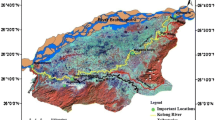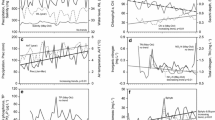Abstract
El Niño and Southern Oscillation (ENSO) is a natural forcing that affects global climate patterns, thereon influencing freshwater quality and security. In the advent of a strong El Niño warming event in 2016 which induced an extreme dry weather in Malaysia, water quality variation was investigated in Kampar River which supplies potable water to a population of 92,850. Sampling points were stratified into four ecohydrological units and 144 water samples were examined from October 2015 to March 2017. The Malaysian Water Quality Index (WQI) and some supplementary parameters were analysed in the context of reduced precipitation. Data shows that prolonged dry weather, episodic and sporadic pollution incidents have caused some anomalies in dissolved oxygen (DO), total suspended solids (TSS), turbidity and ammoniacal nitrogen (AN) values recorded and the possible factors are discussed. The month of March and August 2016 recorded the lowest precipitation, but the overall resultant WQI remained acceptable. Since the occurrence of a strong El Niño event is infrequent and far between in decadal time scale, this paper gives some rare insights that may be central to monitoring and managing freshwater resource that has a crucial impact to the mass population in the region of Southeast Asia.









Similar content being viewed by others
References
Benckiser, G., Schartel, T., & Weiske, A. (2015). Control of NO3− and N2O emissions in agroecosystems: a review. Agronomy for Sustainable Development, 35, 1059–1074.
Binding, C. E., Greenberg, T. A., & Bukata, R. P. (2011). Time series analysis of algal blooms in Lake of the Woods using the MERIS maximum chlorophyll index. Journal of Plankton Research, 33(12), 1847–1852.
Bond, N. R., Lake, P. S., & Arthington, A. H. (2008). The impacts of drought on freshwater ecosystems: an Australian perspective. Hydrobiologia, 600, 3–16.
Chen, W., He, B., Nover, D., Duan, W., Luo, C., Zhao, K., & Chen, W. (2018). Spatiotemporal patterns and source attribution of nitrogen pollution in a typical headwater agricultural watershed in Southeastern China. Environmental Science and Pollution Research, 25, 2756–2773. https://doi.org/10.1007/s11356-017-0685-8.
Chan, N. W., & Ghani, A. A. (2016). Addressing water resources shortfalls due to climate change in Penang, Malaysia, In: Water security and climate change: challenges and opportunities in Asia, 29 November–01 December 2016. Bangkok: Asian Institute of Technology.
Degefu, M. A., & Bewket, W. (2017). Variability, trends, and teleconnections of stream flows with large-scale climate signals in the Omo-Ghibe River Basin, Ethiopia. Environmental Monitoring and Assessment, 189, 142. https://doi.org/10.1007/s10661-017-5862-1.
Department of Environment (DOE). (2008). Malaysia environmental quality report (2008). Kuala Lumpur: Ministry of Natural Resources and Environment Malaysia.
Department of Irrigation and Drainage (DID). (2009). Study on the river water quality trends and indexes in Peninsular Malaysia: Water Resources Publication No. 21, http://irep.iium.edu.my/30722/1/WRP_21_Water_Quality_Trend_and_Index.pdf. Accessed 23 June 2017.
Department of Irrigation and Drainage (DID). (2017). Perak: online river level data, http://infobanjir.water.gov.my/waterlevel_page.cfm?state=PRK. Accessed 11 May 2017.
Economic Planning Unit (EPU). (2000). National Water Resources Study 2000–2050. Kuala Lumpur: Department of Prime Minister’s Office.
Edwards, R. T., & Meyer, J. L. (1987). Metabolism of a sub-tropical low gradient black water river. Freshwater Biology, 17(2), 51–263.
Elosegi, A., & Pozo, J. (2016). Altered organic matter dynamics in rivers and streams: ecological consequences and management implications. Limnetica, 35(2), 303–322.
Ertel, J. R., Hedges, J. I., Devol, A. H., Richey, J. E., & Ribeiro, M. D. M. G. (1986). Dissolved humic substances of the Amazon River System. Limnology and Oceanography, 31(4), 739–754.
Górski, J., Dragon, K., & Kaczmarek, P. M. J. (2017). Nitrate pollution in the Warta River (Poland) between 1958 and 2016: trends and causes. Environmental Science and Pollution Research. https://doi.org/10.1007/s11356-017-9798-3.
Hanna, D. M., Sadler, J. P., & Wood, P. J. (2007). Hydroecology and ecohydrology: a potential route forward? Hydrological Processes, 21, 3385–3390.
Harun, S., Abdullah, M. H., Mohamed, M., Fikri, A. H., & Jimmy, E. O. (2010). Water quality study of four streams within Maliau Basin Conservation Area, Sabah, Malaysia. Journal of Tropical Biology and Conservation, 6, 109–113.
Hladyz, S., Watkins, S. C., Whitworth, K. L., & Baldwin, D. S. (2011). Flows and hypoxic blackwater events in managed ephemeral river channels. Journal of Hydrology, 401(1–2), 117–125.
Jiménez-Muñoz, J. C., Mattar, C., Barichivich, J., Santamaría-Artigas, A., Takahashi, K., Malhi, Y., Sobrino, J. A., & Schrier, G. . . (2016). Record-breaking warming and extreme drought in the Amazon rainforest during the course of El Niño 2015–2016. Scientific Reports, 6, 33130.
Jouanneau, S., Recoules, L., Durand, M. J., Boukabache, A., Picot, V., Primault, Y., Lakel, A., Sengelin, M., Barillon, B., & Thouand, G. (2014). Methods for assessing biochemical oxygen demand (BOD): a review. Water Research, 49, 62–85.
Kennard, M. J., Mackay, S. J., Pusey, B. J., Olden, J. D., & Marsh, N. (2010). Quantifying uncertainty in estimation of hydrologic metrics for ecohydrological studies. River Research and Applications, 26(2), 137–156.
Lakani, F. B., Sattari, M., Sharifpour, I., & Kazemi, R. (2013). Effect of hypoxia, normoxia and hyperoxia conditions on gill histopathology in two weight groups of beluga (Huso huso). Caspian Journal of Environmental Sciences, 11(1), 77–84.
Laubach, J., Taghizadeh-Toosi, A., Gibbs, S. J., Sherlock, R. R., Kelliher, F. M., & Grover, P. P. (2013). Ammonia emissions from cattle urine and dung excreted on pasture. Biogeosciences, 10, 327–338.
Li, Z., Liu, H., Luo, C., Li, Y., Li, H., Pan, J., Jiang, X., Zhou, Q., & Xiong, Z. (2015). Simulation of runoff and nutrient export from a typical small watershed in China using the Hydrological Simulation Program-Fortran. Environmental Science and Pollution Research, 22(10), 7954–7966.
Maeda, E. E., Kim, H., Aragão, L. E. O. C., Famiglietti, J. S., & Oki, T. (2015). Disruption of hydroecological equilibrium in southwest Amazon mediated by drought. Geophysical Research Letters, 42, 7546–7553.
Magaña, V. O., & Conde, C. (2000). Climate and freshwater resources in Northern Mexico: Sonora, a case study. Environmental Monitoring and Assessment, 61, 167–185. https://doi.org/10.1023/A:1006399025537.
Mallin, M. A., Johnson, V. L., Ensign, S. H., & MacPherson, T. A. (2006). Factors contributing to hypoxia in rivers, lakes, and streams. Limnology and Oceanography, 51(1), 690–701.
Meteorological Department Malaysia. (2017). Monthly weather bulletin. http://www.met.gov.my/web/metmalaysia/publications/bulletinpreview/monthlyweather?p_p_id=122_INSTANCE_phshFS8dJslQ&p_p_lifecycle=0&p_p_state=normal&p_p_mode=view&p_p_col_id=_118_INSTANCE_F96odbUpU62g__column-2&p_p_col_count=1&p_r_p_564233524_categoryId=. Accessed 13 May 2017.
Meyer, J. L. (1990). Blackwater perspective on riverine ecosystems. Bioscience, 4(9), 643–651.
Meyer, J. L., & Edwards, R. T. (1990). Ecosystem metabolism and turnover of organic carbon along a blackwater river continuum. Ecology, 71(2), 668–677.
Ministry of Natural Resources and Environment (MNRE). (2009). Study on the river water quality trends and indexes in peninsular Malaysia: Water Resources Publication No. 21 [Online]. Available at: http://irep.iium.edu.my/30722/1/WRP_21_Water_Quality_Trend_and_Index.pdf [Accessed: 05 July 2015].
Ministry of Natural Resources and Environment (MNRE). (2011). The review of national water resource study (2000–2050) and formulation of national water resources policy: final report. http://www.water.gov.my/images/Hidrologi/NationalWaterResourcesStudy/Vol13Perak.pdf. Accessed 09 April 2017.
Mosley, L., Barnett, L., Leyden, E., Fradley, K., Iacopetta, J., Jolley, A. M., Peter, M., Natt, A., Palmer, D., Scott, P., Spencer, J., Stone, D., & Zammit, B. (2013). Water quality in the lower lakes during a hydrological drought: water quality monitoring report. Water and Natural Resources, Adelaide: Department for Environment.
Natural Oceanic and Atmospheric Administration, US (NOAA). (2017). Historical El Niño/La Nina episodes. http://origin.cpc.ncep.noaa.gov/products/analysis_monitoring/ensostuff/ONI_v5.php. Accessed 13 Nov 2017.
O’Connell, M., Baldwin, D. S., Robertson, A. I., & Rees, G. (2000). Release and bioavailability of dissolved organic matter from floodplain litter: influence of origin and oxygen levels. Freshwater Biology, 45, 333–342.
Parolin, P., & Worbes, M. (2000). Wood density of trees in blackwater floodplains of Roi Jau National Park, Amazonia, Brazil. Acta Amazonica, 30(3), 441–448.
Rembold, F., Leo, O., Nègre, T., & Hubbard, N. (2015). The 2015-2016 El Niño event: expected impact on food security and main response scenarios in East and Southern Africa. European Union, EUR 27653, http://publications.jrc.ec.europa.eu/repository/bitstream/JRC98751/lb-na-27653-en-n.pdf. Accessed 03 August 2016.
Rhodes, L. L., Haywood, A. J., Ballantine, W. J., & MacKenzie, A. L. (1993). Algal blooms and climate anomalies in north-east New Zealand, August-December 1992. N. Z. J. Mar. Freshwater Research, 27(4), 419–430.
Rojas, O., Li, Y., & Cumani, R. (2014). Understanding the drought impact of El Niño on the global agricultural areas: an assessment using FAO’s agricultural stress index (ASI). Rome: Food and Agriculture Organization of the United Nations.
Suratman, S., Che Zan, N. H., Aziz, A. A., & Tahir, N. M. (2017). Spatial and seasonal variations of organic carbon-based nutrients in Setiu wetland, Malaysia. Sains Malaysiana, 46(6), 859–865.
Turnbull, L., Wilcox, B. P., Belnap, J., Ravi, S., D’Odorico, P., Childers, D., Gwenzi, W., Okin, G., Wainwright, J., Caylor, K. K., & Sankey, T. (2012). Understanding the role of ecohydrological feedbacks in ecosystem state change in drylands. Ecohydrology, 5(2), 174–183.
Varotsos, C. A., Tzanis, C. G., & Sarlis, N. V. (2016). On the progress of the 2015–2016 El Niño event. Atmospheric, Chemistry and Physics, 16, 2007–2011.
Veldkamp, T. I. E., Eisner, S., Wada, Y., Aerts, J. C. J. H., & Ward, P. J. (2015). Sensitivity of water scarcity events to ENSO driven climate variability at the global scale. Hydrology and Earth System Sciences, 12(6), 5465–5517.
Wallace, T. A., Ganf, G. G., & Brookes, J. D. (2008). A comparison of phosphorus and DOC leachates from different types of leaf litter in an urban environment. Freshwater Biology, 53(9), 1902–1913.
Wang, C., Deser, C., Yu, J. Y., DiNezio, P., & Clement, A. (2017). El Niño and Southern Oscillation (ENSO): a review, In: Coral reefs of the Eastern Tropical Pacific, Coral Reefs of the World 8. New York: Springer Science Publisher.
Wilcox, B. P., Breshears, D. D., & Allen, C. D. (2003). Ecohydrology of a resource-conserving semiarid woodland: effects of scale and disturbance. Ecological Monographs, 73, 223–239.
Wittig, R., König, K., Schmidt, M., & Szarzynski., J (2007). A study of climate change and anthropogenic impacts in West Africa. Environmental Science and Pollution Research, 14(3), 182–189.
World Meteorological Organization (WMO). (2014). El Niño Southern Oscillation. Geneva, Switzerland, http://www.wmo.int/pages/prog/wcp/wcasp/documents/JN142122_WMO1145_EN_web.pdf. Accessed 10 August 2015.
Zainudin, Z. (2008). The many intricacies of biochemical oxygen demand, In: Jurutera monthly bulletin. Kuala Lumpur: Institution of Engineers Malaysia (IEM).
Acknowledgements
We are grateful to Samberan bin Bah Pasu of Ulu Kampar village who assisted in the study. We are also thankful to anonymous reviewers who have provided valuable comments. This manuscript would not be possible without their contributions.
Author information
Authors and Affiliations
Corresponding author
Rights and permissions
About this article
Cite this article
Ng, C.KC., Goh, CH., Lin, JC. et al. Water quality variation during a strong El Niño event in 2016: a case study in Kampar River, Malaysia. Environ Monit Assess 190, 402 (2018). https://doi.org/10.1007/s10661-018-6784-2
Received:
Accepted:
Published:
DOI: https://doi.org/10.1007/s10661-018-6784-2




